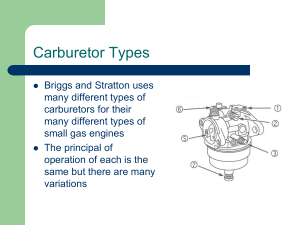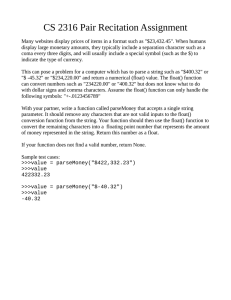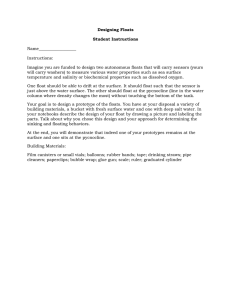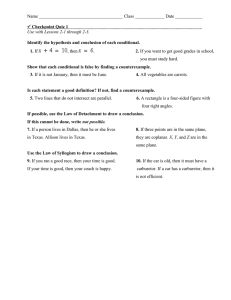Chapter IV Float Carburetor Service And Maintenance
advertisement
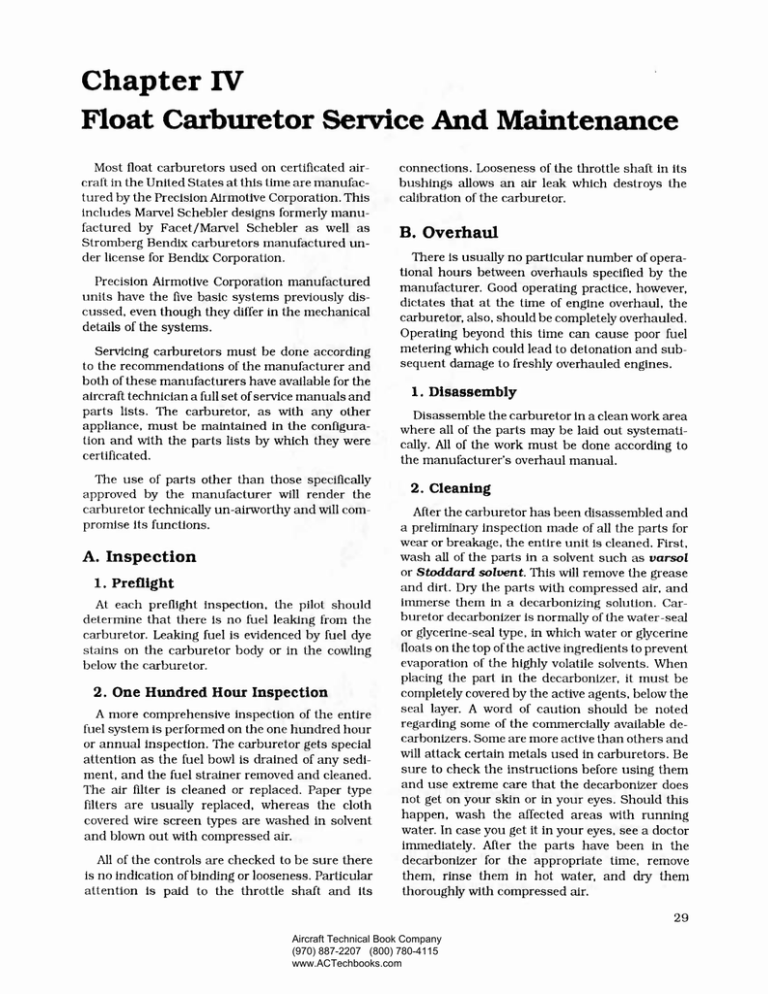
Chapter IV Float Carburetor Service And Maintenance Most float carburetors used on certificated aircraft in the United States at this time are manufactured by the Precision Airmotive Corporation. This includes Marvel Schebler designs formerly manufactured by Facet/Marvel Schebler as well as Stromberg Bendix carburetors manufactured under license for Bendix Corporation. Precision Airmotive Corporation manufactured units have the five basic systems previously discussed, even though they differ in the mechanical details of the systems. Servicing carburetors must be done according to the recommendations of the manufacturer and both of these manufacturers have available for the aircraft technician a full set of service manuals and parts lists. The carburetor, as with any other appliance, must be maintained in the configuration and with the parts lists by which they were certificated. The use of parts other than those specifically approved by the manufacturer will render the carburetor technically un-airworthy and will compromise its functions. A. Inspection Preflight At each preflight inspection, the pilot should determine that there is no fuel leaking from the carburetor. Leaking fuel is evidenced by fuel dye stains on the carburetor body or in the cowling below the carburetor. One Hundred Hour Inspection A more comprehensive inspection of the entire fuel system is performed on the one hundred hour or annual inspection. The carburetor gets special attention as the fuel bowl is drained of any sediment, and the fuel strainer removed and cleaned. The air filter is cleaned or replaced. Paper type filters are usually replaced, whereas the cloth covered wire screen types are washed in solvent and blown out with compressed air. All of the controls are checked to be sure there is no indication of binding or looseness. Particular attention is paid to the throttle shaft and its connections. Looseness of the throttle shaft in its bushings allows an air leak which destroys the calibration of the carburetor. B. Overhaul There is usually no particular number of operational hours between overhauls specified by the manufacturer. Good operating practice, however, dictates that at the time of engine overhaul, the carburetor, also, should be completely overhauled. Operating beyond this time can cause poor fuel metering which could lead to detonation and subsequent damage to freshly overhauled engines. Disassembly Disassemble the carburetor in a clean work area where all of the parts may be laid out systematically. All of the work must be done according to the manufacturer's overhaul manual. Cleaning After the carburetor has been disassembled and a preliminary inspection made of all the parts for wear or breakage, the entire unit is cleaned. First, wash all of the parts in a solvent such as varsol or Stoddard solvent. This will remove the grease and dirt. Dry the parts with compressed air, and immerse them in a decarbonizing solution. Carburetor decarbonizer is normally of the water-seal or glycerine-seal type, in which water or glycerine floats on the top of the active ingredients to prevent evaporation of the highly volatile solvents. When placing the part in the decarbonizer, it must be completely covered by the active agents, below the seal layer. A word of caution should be noted regarding some of the commercially available decarbonizers. Some are more active than others and will attack certain metals used in carburetors. Be sure to check the instructions before using them and use extreme care that the decarbonizer does not get on your skin or in your eyes. Should this happen, wash the affected areas with running water. In case you get it in your eyes, see a doctor immediately. After the parts have been in the decarbonizer for the appropriate time, remove them, rinse them in hot water, and dry them thoroughly with compressed air. 29 Aircraft Technical Book Company (970) 887-2207 (800) 780-4115 www.ACTechbooks.com Figure 4-1. Exploded view of typical aircraft float carburetor. 3. Inspection After all of the parts have been cleaned, they must be carefully inspected for any indication of damage or wear. Needle valves and seats should be especially examined for indications of grooves or scratches. Some models of Bendix carburetors allow the needle valve and seat to be lapped together to facilitate complete sealing, but all 30 Aircraft Technical Book Company (970) 887-2207 (800) 780-4115 www.ACTechbooks.com Precision Airmotive carburetors require the float valve and seat assembly to be replaced with new units at each overhaul. All of the parts subject to wear should be checked against a table of limits or replaced, again following the instructions of the manufacturer in detail. Parts Replacement The throttle shaft bushings are subject to the most wear, and will likely have to be replaced. Precision Airmotive recommends about a 0.003 inch loose fit for the throttle shaft in the bushing. The old bushings are driven out by screwing a bushing removal tool into the bushing and driving it out with a hammer. When the new bushings are to be inserted, the holes should be cleaned out and the new bushings pressed in, using an arbor press and the proper size tool. The bushings are line reamed to assure that they are in perfect alignment. When reaming a bushing, be sure the reamer is turned in the cutting direction, both as it goes into the bushing and as it is drawn out. Reversing the direction of the reamer dulls the cutting edge and causes scratches on the inside of the bushing. Precision Airmotive now uses an oilite bronze bushing instead of stainless steel. When these bushings are used, the outside surface is lightly coated with Locktite compound and inserted into the bushing hole. An aligning tool is inserted through both bushings and the Locktite allowed to cure for two to four hours at room temperature. The dimensions of the hole for this type of bushing are not nearly so critical as when pressing a bushing in to be reamed. Locktite can fill clearances up to about 0.005 inch. Throttle shaft packings between the throttle bore and the float bowl in the MSA carburetors must be replaced. Leaking packings cause considerable trouble and an easy method to check before proceeding is recommended. Invert the casting and pour a test liquid into the cavity to cover packings. Blow compressed air from the outside. If leaking is observed, replace the packings and retainers. A LEAKING OR WORN INNER PACKING CREATES A LEAN CONDITION. A LEAKING OUTER PACKING CAUSES A RICH CONDITION. Reassembly In reassembly, many operations require the use of special tools. It is poor economy to use anything other than the proper tool for some of these specialized jobs since an incorrect tool may damage a part costing far more than the tool. Most carburetor bodies are made of aluminum alloy castings. When installing straight plugs or jets, apply a small amount of engine oil to the threads. When installing tapered plugs, insert the plug into the casting for one thread and apply a small amount of thread lubricant such as "Titesear to the second thread of the plug. Screwing the plug into the hole squeezes the lubricant between the threads and prevents galling. Extreme care should be taken to see that none of this compound is allowed to get inside the carburetor since it is insoluble in gasoline and may plug jets or passages. The needle seat and valve are installed with the float, and the float level is one of the more critical adjustments of this type carburetor. MSA carburetors have the float suspended from the throttle body and the proper float level is measured by slipping the shank of the proper size twist drill between the gasket and the float with the throttle body inverted; Figure 4-2. The drill should touch the float but not cause it to rise. If the float level is not correct, it may be adjusted by adding or removing shims from below the valve seat. Adding shim thickness increases the float clearance and lowers the fuel level in the float bowl. Removing shims has the opposite effect. After getting the proper float level, the side clearance of the float in the bowl is checked, Figure 4-3. A special tool consisting of a cut-away float bowl is installed over the float, and a drill rod gauge passed completely around the float. The float should not be so close to the body that the gauge will bind at any point around either of the two floats. This clearance may be adjusted by loosening and repositioning the float bracket. The amount of float drop should be checked by turning the throttle body right side up, Figure 4-4, and measuring the clearance between the gasket and the tip of the float. Adjustment of this distance is made by grinding or filing the float bracket tang. Floats mounted in the fuel bowl are adjusted to provide the proper level of the fuel in the bowl. The bowl assembly with the needle, seat, and float installed is mounted on the test bench and leveled both parallel and perpendicular to the float axis. Fuel of the proper specific gravity with the correct inlet pressure is fed into the bowl. The distance between the parting surface of the bowl and the level of the fuel is measured with a depth gauge. A 31 Aircraft Technical Book Company (970) 887-2207 (800) 780-4115 www.ACTechbooks.com Figure 4-2. The proper float level Is measured with the appropriate twist drill between the tip of the float and the gasket. correction for specific gravity other than standard is made according to the following table: TEST FUEL SPECIFIC GRAVITY 0.675 0.685 0.693 0.700 0.710 0.720 0.727 0.735 0.745 CORRECT FLOAT LEVEL Subtract 1 /16" from Specified Level Subtract 3/64" from Specified Level Subtract 1 /32" from Specified Level Subtract 1 /64" from Specified Level Use Specified Level Add 1 /64" to Specified Level Add 1 /32" to Specified Level Add 3/64" to Specified Level Add 1 /16" to Specified Level buretors is adjusted by setting the throttle butterfly valve at the angle specified in the overhaul manual, and adjusting the lower nut on the economizer needle until it just contacts the forks. Lock the adjustment by screwing the upper nut tight against the lower. The airbleed type economizer used by Precision Airmotive on MA4-5,-6 series, is adjusted by opening the throttle wide and adjusting the depth to which the air metering valve is screwed into the If the fuel level is too high, shims may be added beneath the needle seat. A low fuel level is raised by decreasing the shim thickness. When measuring the fuel level, be sure the scale is held away from the wall of the bowl. The fuel has a tendency to "wet" the bowl wall, and the level at the wall will be higher than the correct measurement taken in the open part of the bowl. Apply the test pressure specified by the manufacturer to see that the needle valve does not leak. Precision Airmotive recommends six pounds of fuel pressure be applied to the fuel intake for fifteen minutes. The fuel should not rise to the lip of the discharge nozzle in this time. This may be checked by looking into the discharge nozzle with an otoscope. After the carburetor has been assembled, the economizer or enrichment system should be adjusted. The needle type used on the Bendix car- Figure 4-3. A gauge made from a float bowl with the bottom cut out is placed over the floats and the proper size twist drill must pass completely around both floats without binding. 32 Aircraft Technical Book Company (970) 887-2207 (800) 780-4115 www.ACTechbooks.com throttle body This may be checked by either a depth gauge or a special air metering pin gauge, Figure 4-5. C. Installation 1. Mounting After the carburetor has been overhauled, or has been received from an accessory shop to be installed on an engine, it is checked to be sure the proper safeties and seals are intact. The serial number is recorded in the engine records, and you must assure yourself that the parts list number or assembly number for the carburetor is that required for your particular engine. Mount the carburetor on the engine using a new gasket and torque the hold-down nuts as specified by the engine manufacturer. Connect all of the controls and make sure the cockpit control moves through its complete travel and the stop on the carburetor is reached before the stop in the cockpit. In the case of multi-engine aircraft, the controls for all engines must be aligned in both the full forward and the full rearward position. The carburetor air scoop should be installed with particular attention paid to the fully open and fully closed position of the air valve. The air filter should be checked to see that there is no leak around the filter element where unfiltered air could be drawn into the carburetor. Before connecting the fuel line, it is a good practice to open the fuel valve and drain a small amount of fuel out Figure 4-4. If the float drop is not correct, file the tang of the float bracket. 33 Aircraft Technical Book Company (970) 887-2207 (800) 780-4115 www.ACTechbooks.com
